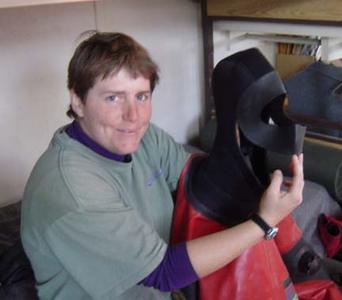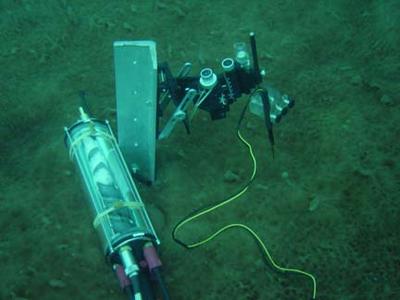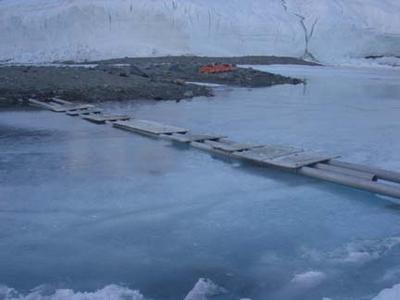20 November, 2004
Muffled talk and "Don't put the buggy in the moat!"
Temperature: 32*F
Location: Lake Hoare
Before coming to Antarctica, I promised my family and friends that I would not
take any unnecessary risks. Today, I honored that promise; I was in a
situation that pushed my comfort zone just a little too far, so I got myself
out of the situation. Now it makes a good story!
My dry suit has an attached hood with a face seal around the edges which seals
against my face preventing water from entering the hood. This morning, while I
was getting suited up to dive, part of the face seal tore away from the hood.
The tear extended from the chin to about ear level. I then had a hood with an
odd chin strap!
I decided to wear my "beanie" hood under my dry suit hood for extra warmth, and
the band helmet would most likely seal off most water from getting into the
hood. It is common for people to dive with hoods arranged in such a fashion.
We agreed, that if I was cold, I would end the dive. We suited up to dive,
and I jumped in the water. Very little water entered the hood area, and I was
plenty warm, so I continued with the dive.
My main mission was to capture photographs of parcticular regions of the lake
bottom. The dive was going quite well, but then the loose "chin strap" on my
hood started sliding up into my helmet. First it loosely covered my mouth, but
I could still breath quite easily. When wearing a band helmet, one can breathe
through both nose and mouth. I continued working, but then the strap covered
my mouth a little more tightly, yet I could still breathe easily through my
nose. I adjusted the helmet to move the strap off my mouth, which it did.
The biggest problem at this point was that Ian, who was tending the dive, was
having trouble understanding what I was saying. All my words were muffled from
the strap. I shot off a few more pictures, but then the strap moved again. It
was now touching, but not blocking both my nose and mouth. Even though I was
able to breathe easily, I decided that the potential for problems and the
inability to communicate clearly with the surface made it time to end the dive.
I headed back to the hole and got out. Ian and I had a good chuckle about the
"muffled talk."
Ian had a very successful dive! He took the oxygen sensor to the lake bottom
and took an oxygen profile through the mat. This requires precise
measurements with quite technical equipment. Kay recorded the data and then
imported the data to his computer. The results were spectacular. The oxygen
levels fluctuate precisely with the layers within the mat. This gives Ian
great strides in his ability to understand the oxygen production levels of the
algal mat.
While Ian and I made our dives, the Antarctic sun continued to warm the valley.
Running water could clearly be heard both within and beside the glacier. Small
waterfalls are cascading down the sides of the glacier, the moat is melting; we
even have water streaming into our dive hole.
This afternoon, I shuttled four people on the ATV to the opposite end of the
lake. I had to drive the ATV right on the edge of the permanent lake ice so
that it wouldn't break through the moat. No one would get hurt if the ATV went
through the moat, but the ATV would most likely get stuck and it would be an
environmental disaster for the lake. When driving around Lake Hoare, "Don't
put the buggy in the lake!"

1. The latest fashion in "chin strapped" hoods!

2. Algal mat at the bottom of Lake Hoare.

3. Another look at the algal mat.

4. The underwater oxygen sensor in action. The sensor readout is on the left hand side. The micro-manipulator, which allows the diver to control the depth of each movement, is the arm extending to the right, and the actual sensor is on the far right pointing towards the mat.

5. Our make-shift bridge to get across the melting moat!

6. The view out our lab window in camp; spectacular!
Contact the TEA in the field at
.
If you cannot connect through your browser, copy the
TEA's e-mail address in the "To:" line of
your favorite e-mail package.
|
